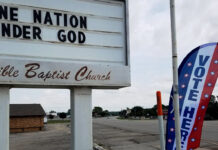Today, Palm Sunday, begins Holy Week in most Christian faiths throughout the world. Palm Sunday is a reference to the victorious entrance of Jesus into Jerusalem to celebrate the feast day of Passover. The story is told in all four Gospels that as Jesus came toward Jerusalem the people ran out and proclaimed, “Hosanna,”which in Hebrew means “save,” and is a reference to the belief that Jesus was coming to save his people. It was a parade full of smiles, shouting, waving branches, and the happiness of hope. Everybody loves a parade!
In those times, if a king or general rode in on a horse, he was telling the citizens of that city that he was coming to rule with an iron fist. On the other hand, if he entered riding on a donkey, it was symbolic to the people that he was coming in peace.
One of the primary reasons why Jesus was rejected as the Messiah by the Jewish people was that he did not come as conqueror, but instead came as a bringer of peace. They were expecting him to be the one to remove the Romans, and when he didn’t start a revolution to do that, he was quickly rejected. Jesus came as the King of Peace, and his riding on a donkey into the city was a testament to his true intentions.
Palm branches had great symbolic significance in the time of Jesus as well. In Mesopotamia, these branches were symbols of triumph, eternal life, and peace. When Jesus entered the city and the people laid palm branches at his feet, it was symbolic of their recognition of him as King.
Luke 19:36-37 adds the detail that the people put their cloaks on the road as Jesus approached them. Keep in mind that in those days fiber was not easy to create in mass quantities, and so garments were laid at people’s feet as a sign of respect and acknowledgement of their position. When the people laid their garments before Jesus, they were in essence, rolling out the red carpet for him.
Today, as millions of Christians around the world celebrate Palm Sunday, they will follow these traditions of the church. Children will march in with palm branches. Songs will be sung. Some churches will even recreate this amazing parade into Jerusalem by bringing a donkey into services. It’s easy to forget that in less than a week, Jesus will be crucified by the very people creating this parade today. Only a single week separates these two events, 5 days to be exact. Have you ever wondered why and how Jesus and his followers went from jubilation to grief in such a short time?
What most people are unaware of is that there was another procession entering Jerusalem that day from the west side, with Pilate at the head of Roman imperial military reinforcements for the garrison at Jerusalem. During Passover, the holiest celebration of the Jewish faith, when thousands upon thousands of faithful Jewish people would travel to Jerusalem, Rome found it necessary to show its strength and add to the forces there just in case the Jews, who wanted so badly to end Roman occupation of their land, decided to cause any trouble.
Imagine the imperial procession’s arrival into the city: a visual display of imperial power, a parade of strength and might, cavalry on horses, foot soldiers, leather armor, helmets, weapons, banners, golden eagles mounted on poles, sun shining on metal and gold, the marching of feet, the creaking of leather, the clinking of bridles, the beating of drums, the swirling of dust. The onlookers, some curious, some in awe, some resentful, and some afraid, must have been drawn to it. They couldn’t look away; it was such a sight.
Pilate entering the city from the west while Jesus entered the city from the east; Jesus’ procession symbolized a kingdom of peace, the Roman procession a manifestation of imperial power, oppression, and violence. And those two contrasting parades—between the kingdom of God and the kingdom of Caesar—present the central conflict for the events of Holy Week, for early Christianity, and for us 2000 years later.
Today, we ask ourselves, which parade are we following? Do we put our faith in power and money, being drawn to the spectacle of the sight and the noise? Or do we put our faith in love and christian ministry, following in the footsteps of the one who taught peace?
Five days later, Jesus would be sent to his death, not only because he challenged Rome and Rome’s oppression of his people, but also because he challenged the religious leaders of his time, those who controlled the synagogue, those who collaborated with Roman rulers and who thereby legitimized the domination of the Jewish people by Rome. Jesus’ vision of the kingdom of God led him to speak and act against this conspiracy between church and state.
The people of Jesus’s time , even his disciples, were hoping for a warrior Messiah who would free the Jews from Roman oppression, just as Moses had led the Israelites out of slavery in Egypt. However, Jesus would have a different path for salvation, a selfless sacrifice which is graphically seen in Christ’s passion and death which we will honor in five days time on Good Friday.
Until then, we wave our palm branches today and remember that to follow the way of Jesus is to voice the way of peace and justice, to care for the poor, to speak for the marginalized and downtrodden, to point out injustice wherever it exists. As we journey with Jesus through all the days of Holy Week, may we seek peace and love in our own lives and share justice and mercy with all we meet.
28 After Jesus said this, he continued on ahead, going up to Jerusalem.
29 As Jesus came to Bethphage and Bethany on the Mount of Olives, he gave two disciples a task. 30 He said, “Go into the village over there. When you enter it, you will find tied up there a colt that no one has ever ridden. Untie it and bring it here. 31 If someone asks, ‘Why are you untying it?’ just say, ‘Its master needs it.’” 32 Those who had been sent found it exactly as he had said.
33 As they were untying the colt, its owners said to them, “Why are you untying the colt?”
34 They replied, “Its master needs it.” 35 They brought it to Jesus, threw their clothes on the colt, and lifted Jesus onto it. 36 As Jesus rode along, they spread their clothes on the road.
37 As Jesus approached the road leading down from the Mount of Olives, the whole throng of his disciples began rejoicing. They praised God with a loud voice because of all the mighty things they had seen. 38 They said,
“Blessings on the king who comes in the name of the Lord.
Peace in heaven and glory in the highest heavens.”
39 Some of the Pharisees from the crowd said to Jesus, “Teacher, scold your disciples! Tell them to stop!”
40 He answered, “I tell you, if they were silent, the stones would shout.”




